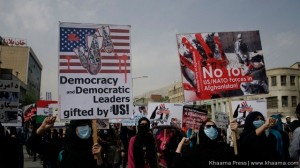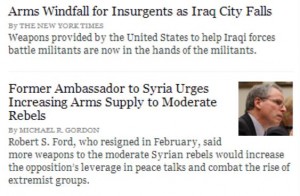CIA to Stein: “Sorting Syrian Fighters is Hard!”
Jeff Stein has a fascinating read over at Newsweek. From the url, I’m guessing that Stein titled his piece “Moderate Rebels Please Raise Your Hands”, but his editors eventually went with “Inside the CIA’s Syrian Rebels Vetting Machine“. As Stein notes in his opening, the impossibility of finding “moderate” rebels in Syria who are willing to take up arms against the regime of Bashar al-Assad but who won’t eventually get into committing atrocities or push a radical Islamist view has led to much derision of the US plan. Stein notes efforts by Andy Borowitz and Jon Stewart in that arena, although I have played along too (here and here).
But Stein actually took the time to talk to people who have been involved in the effort. What he found is not encouraging at all:
Behind the jokes, however, is the deadly serious responsibility of the CIA and Defense Department to vet Syrians before they receive covert American training, aid and arms. But according to U.S. counterterrorism veterans, a system that worked pretty well during four decades of the Cold War has been no match for the linguistic, cultural, tribal and political complexities of the Middle East, especially now in Syria. “We’re completely out of our league,” one former CIA vetting expert declared on condition of anonymity, reflecting the consensus of intelligence professionals with firsthand knowledge of the Syrian situation. “To be really honest, very few people know how to vet well. It’s a very specialized skill. It’s extremely difficult to do well” in the best of circumstances, the former operative said. And in Syria it has proved impossible.
Daunted by the task of fielding a 5,000-strong force virtually overnight, the Defense Department and CIA field operatives, known as case officers, have largely fallen back on the system used in Afghanistan, first during the covert campaign to rout the Soviet Red Army in the 1980s and then again after the 2001 U.S. invasion to expel Al-Qaeda: Pick a tribal leader who in turn recruits a fighting force. But these warlords have had their own agendas, including drug-running, and shifting alliances, sometimes collaborating with terrorist enemies of the United States, sometimes not.
“Vetting is a word we throw a lot around a lot, but actually very few people know what it really means,” said the former CIA operative, who had several postings in the Middle East for a decade after the 9/11 attacks. “It’s not like you’ve got a booth set up at a camp somewhere. What normally happens is that a case officer will identify a source who is a leader in one of the Free Syrian Army groups. And he’ll say, ‘Hey…can you come up with 200 [guys] you can trust?’ And of course they say yes—they always say yes. So Ahmed brings you a list and the details you need to do the traces,” the CIA’s word for background checks. “So you’re taking that guy’s word on the people he’s recruited. So we rely on a source whom we’ve done traces on to do the recruiting. Does that make sense?”
There is, of course, a huge problem with this approach:
A particularly vivid example was provided recently by Peter Theo Curtis, an American held hostage in Syria for two years. A U.S.-backed Free Syrian Army (FSA) unit that briefly held him hostage casually revealed how it collaborated with Al-Qaeda’s al-Nusra Front, even after being “vetted” and trained by the CIA in Jordan, he wrote in The New York Times Magazine.
“About this business of fighting Jabhat al-Nusra?” Curtis said he asked his FSA captors.
“Oh, that,” one said. “We lied to the Americans about that.”
But it is even worse. Consider this bit about the details of how the “trace” is carried out:
American embassies around the world are open to just about anybody who wants to sign up for the FSA. “They fill out a form. You get their four-part name, their date of birth, and then their tribe and where they’re from and all that,” the former operative explained. “Their work history, if there is any. Then you take that and run your traces through all your databases—your HUMINT and SIGINT [agency acronyms for information from human spies and National Security Agency intercepts, called signals intelligence]. And then you take certain aspects of that information, and you sanitize it, and you send it by cable to your station in whatever country, and you ask for their traces on this individual, to see if anything comes up.
“The problem with that process,” the former operative continued, “is when you have a person sitting at a computer who doesn’t know how to standardize Arabic names.… They may translate it correctly, but the person typing it in may or may not know how to look for it with all the name variances that might already be in the system.”
That one is just jaw-dropping. I have a hot tip for those folks tasked with tracing. A super-secret piece of software known as Google seems perfectly able to handle searches of names of groups or people. Whenever I Google new names, I often get back hits on variant transliterations without having to feed them into the search separately.
At any rate, though, when I first saw this article flit by last night, I jokingly suggested on Twitter that the CIA needs the Hogwarts sorting hat:
One important point that the CIA is missing, though, is that it seems to me that anyone who is stepping forward to want weapons and other support for the Syrian war has already self-selected to a large extent. And they are much more likely to be Slytherin than Gryffindor.



